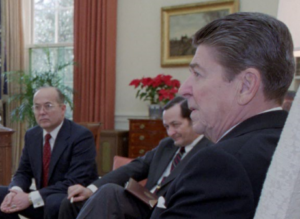
The American police state has been a work in progress for seventy years.
Part One of two parts.
Click for Part Two
Most Americans don’t pay much attention to what the government does in foreign nations, and even less attention to what it has done in the past. There’s nothing inherently wrong with this focus on the here-and-now, but contemplation beyond the usual horizons is well-advised. Not for the usual high-minded reasons offered by multiculturalist do-gooders, but because what the government—and those who pull its strings—have done in foreign lands for the past seventy years is their template for what they plan here at home.
The group that led the US through World War II was determined to preserve, perpetuate, and extend its global dominance. With the establishment of the Office of Strategic Services (OSS), centralized, coordinated intelligence had come into its own. After the war President Truman dissolved the OSS, but signed the National Security Act of 1947, which established the CIA. With a secret executive order in 1952, he also established the NSA. Although the agencies were sold to Truman as necessary instruments for gathering and analyzing foreign intelligence, rather than operational assignments, they soon were engaging in both domestic and foreign operations. In 1963, a month after President Kennedy’s assassination, former president Truman’s letter to the Washington Post deplored what the CIA had become.
For some time I have been disturbed by the way CIA has been diverted from its original assignment. It has become an operational and at times a policy-making arm of the Government. This has led to trouble and may have compounded our difficulties in several explosive areas.
Later, Truman told biographer Merle Miller that setting up the CIA was “a mistake.”
Truman did not mention what the CIA’s disturbing operational and policy-making roles had been, or in what “explosive areas.” The CIA had sponsored coups in Syria (1949), Iran (1953), Guatemala (1954), Congo (1960), the Dominican Republic (1960), and attempted coups in Indonesia (1958) and Cuba (1961, the Bay of Pigs). While the phrase “regime change” didn’t seep into the popular consciousness until the US’s second Iraq invasion in 2003, it had been standard CIA policy for over five decades. To the limited extent its involvements were acknowledged in the 1950s and 1960s, they were generally characterized as necessary efforts in the struggle against global communism.
DEEP SIX THE DEEP STATE!

AMAZON PAPERBACK
KINDLE EBOOK
What has never been acknowledged is what would have been—if the CIA was involved—a domestic coup, President Kennedy’s assassination. The assassination and its aftermath illustrate the psychological obstacles among the public for those attempting to uncover and expose the intelligence community’s misdeeds. Notwithstanding gaping holes in the official story, and obvious questions about the motives of Lyndon Johnson and Alan Dulles, the former director of the CIA who had been fired by Kennedy and stage-managed the Warren Commission investigation, most Americans bought the story and asked no questions. For the few that did, the CIA coined the pejorative, “conspiracy theorist.”
The CIA has a chilling catalogue of countermeasures against the US government’s enemies, most developed during the Vietnam War. The heart of the CIA effort was Operation Phoenix, begun in 1965. Phoenix was designed, coordinated, and executed by the agency jointly with the US military and its intelligence units, the South Vietnamese military and its secret police, and Australian special operations forces. Its mission was to neutralize the infrastructure of the National Liberation Front of South Vietnam (NLF or Viet Cong) through infiltration, capture, counter-terrorism, interrogation, and assassination.
Identification of NLF cadres was problematic. Anyone with a score to settle could misidentify enemies as Viet Cong, who would then be captured or killed by US and South Vietnamese troops. Prisoners were taken to interrogation centers, indefinitely detained, tortured, and sometimes murdered. The interrogations were supposedly done by the South Vietnamese under the supervision of the military or CIA, but the torture was an open secret and often performed by US personnel. Prisoners were converted to the South Vietnamese cause and reinserted into the local population or turned into double agents. They had to produce intelligence about the NLF: their families, friends, and hamlets were essentially hostages securing their performance. Prisoners who produced no information or false information under torture were murdered. Undoubtedly some had no “worthwhile” information to give because they weren’t NLF, but innocence was not a recognized defense.
Phoenix terrorized both the North and South Vietnamese. It was essentially a CIA and US military-imposed police state (with the South Vietnamese government as a junior partner) employing standard police-state tactics: surveillance, informants, propaganda, repression, rubber-stamp judicial supervision, indefinite detention, interrogation, torture, and murder. Like all police states, Phoenix was rife with corruption. South Vietnamese officials, CIA agents and contractors, and US military officials made fortunes from blackmail, extortion, bribery, theft, murder-for-hire, black market arms sales, money laundering, drug running, and other illicit endeavors.
During the war the CIA maintained its usual shroud of plausible deniability, helped by the captive US media, which in many cases had been infiltrated by CIA operatives under the auspices of Operation Mockingbird. Many of Phoenix’s more sordid aspects were not revealed until after the US left Vietnam, and while nobody claims Phoenix wasn’t dirty (even an anodyne Wikipedia article acknowledges the misdeeds), the extent of the dirtiness remains—as so much of what the CIA does—murky. However, a string of CIA engagements after Vietnam retroactively confirmed the nefarious nature of Phoenix—the program was the template for that later criminality.
It should have raised eyebrows when Ronald Reagan nominated a former director of the CIA, George H.W. Bush, as his vice president, but it didn’t. The evolving Deep State saw Bush, and other “vetted” members of Reagan’s administration, as checks on some of Reagan’s more “radical” impulses and initiatives. CIA operatives had been involved in Watergate. Congressional committees had revealed CIA skullduggery in Vietnam, involvement in political assassination, and illegal domestic surveillance of the war’s critics by many of the intelligence agencies and the FBI. Yet most Americans still held a generally benign view of the intelligence complex.
The Iran-Contra affair should have been a wake-up call. The scandal’s many disturbing skeins and offshoots—the CIA’s subversion of governments and sponsorship of political assassination in Latin America, involvement in the drug trade and money laundering through a shadowy network of financial institutions, and covert weapons transactions—cried out for further investigation, which would have revealed a Phoenix program gone global. Instead, Reagan’s popularity and his begrudging acceptance of responsibility, the administration’s stonewalling of investigations and refusal to release documents on national security grounds, and George W. Bush’s pardons in the final days of his presidency for Reagan administration officials still under indictment managed to shove Iran-Contra down the American memory hole. Reagan and Bush served the Deep State well.
Next: Phoenix in the United States
AMERICA IN A HAPPIER TIME

AMAZON
KINDLE
NOOK




